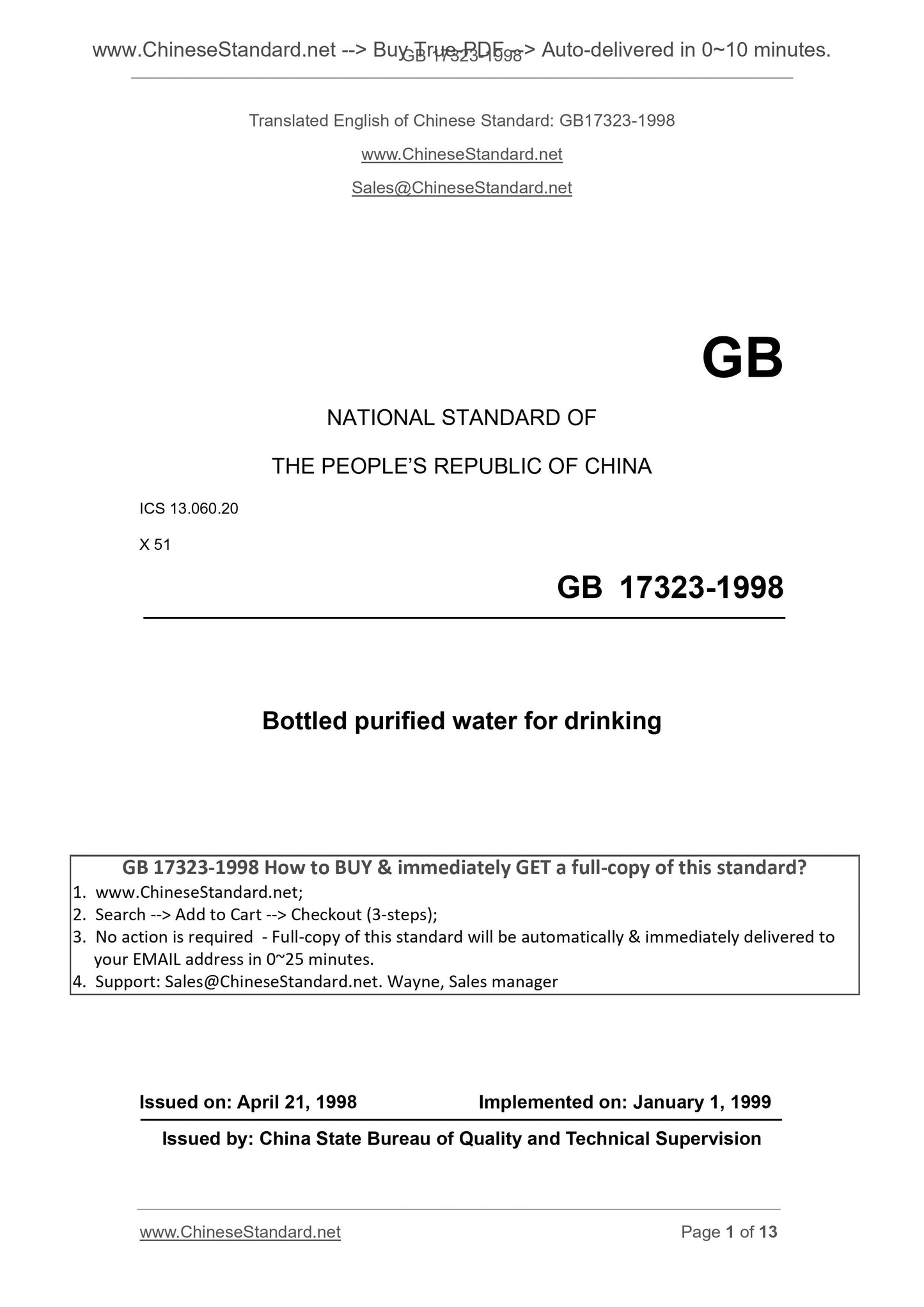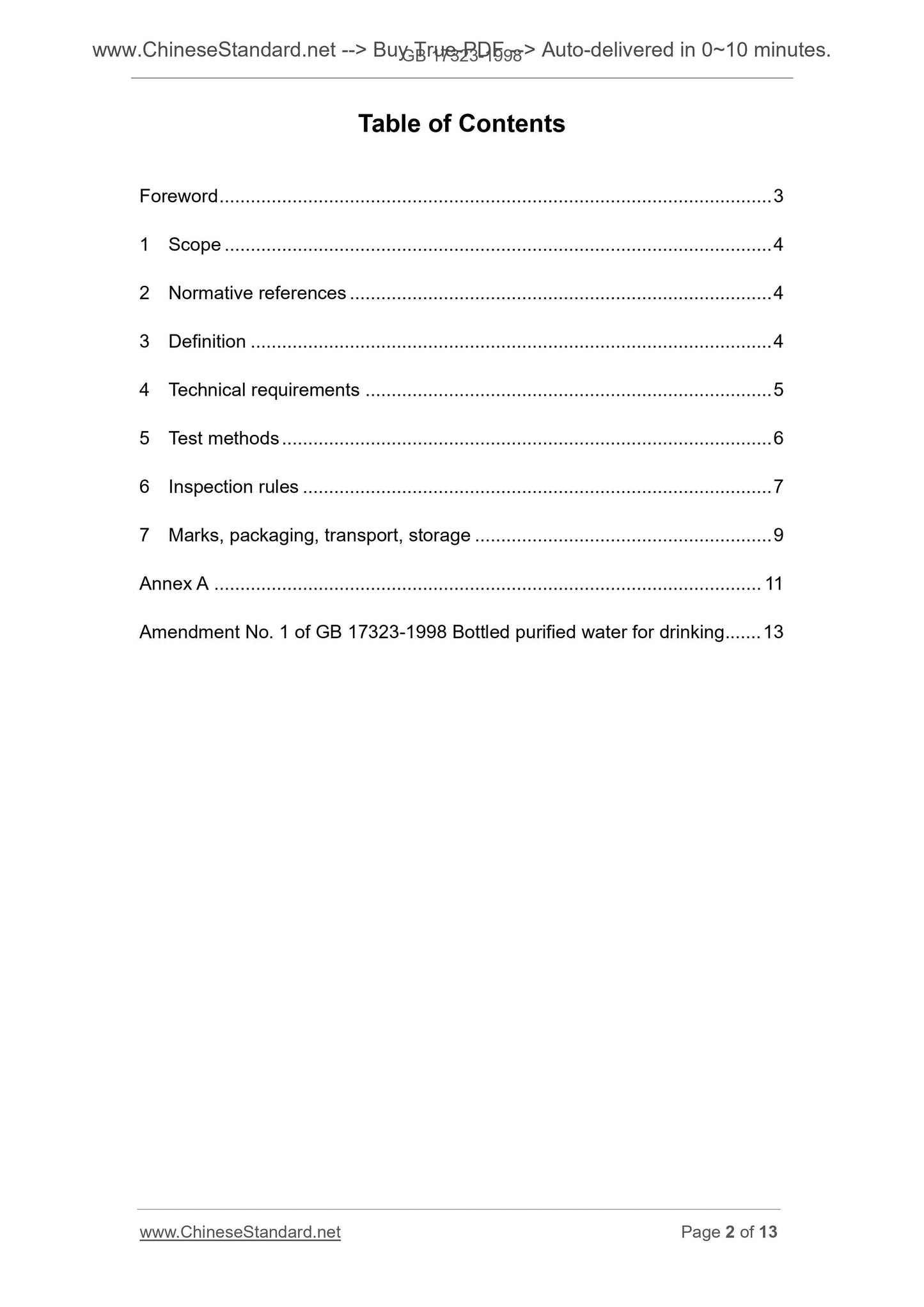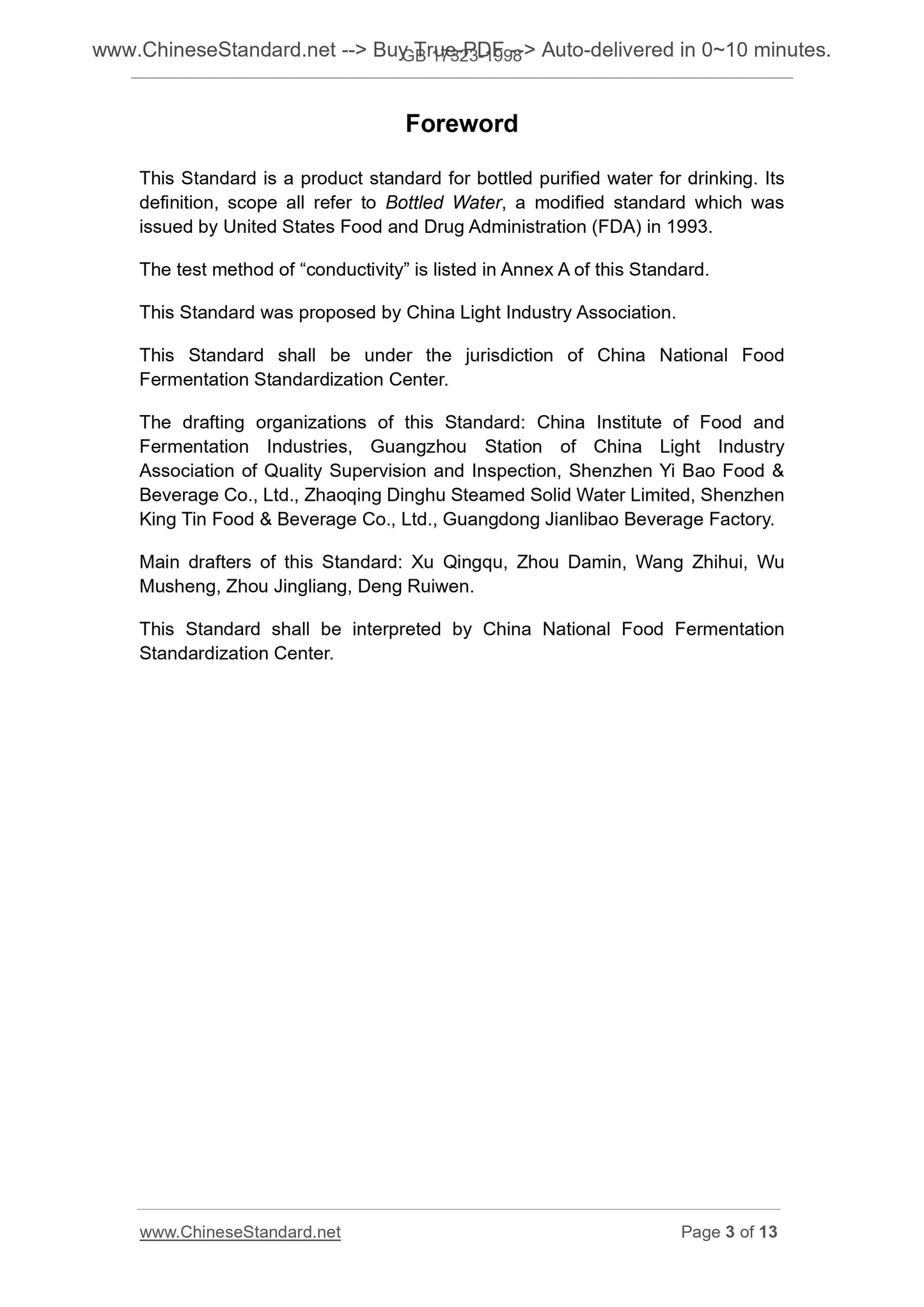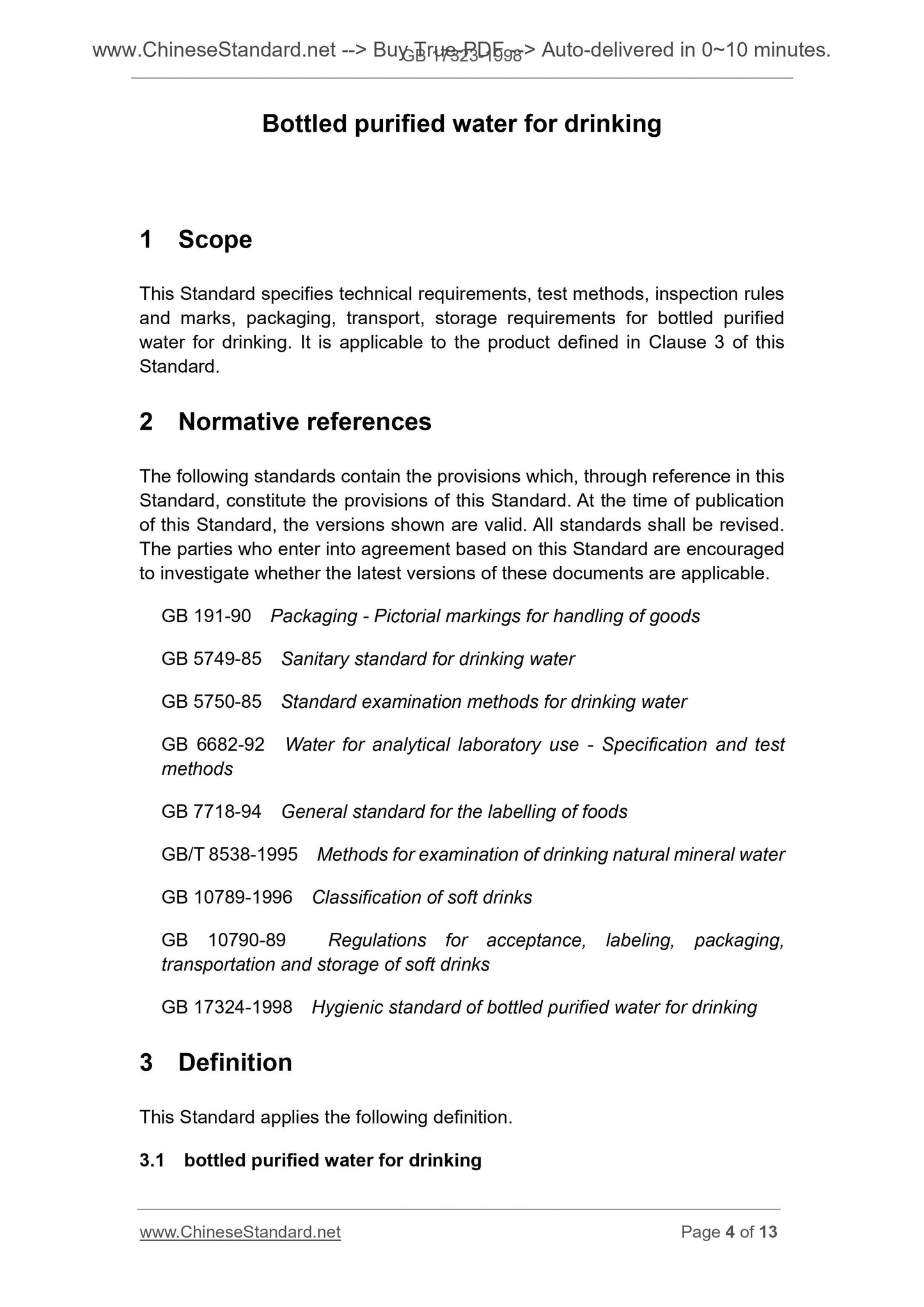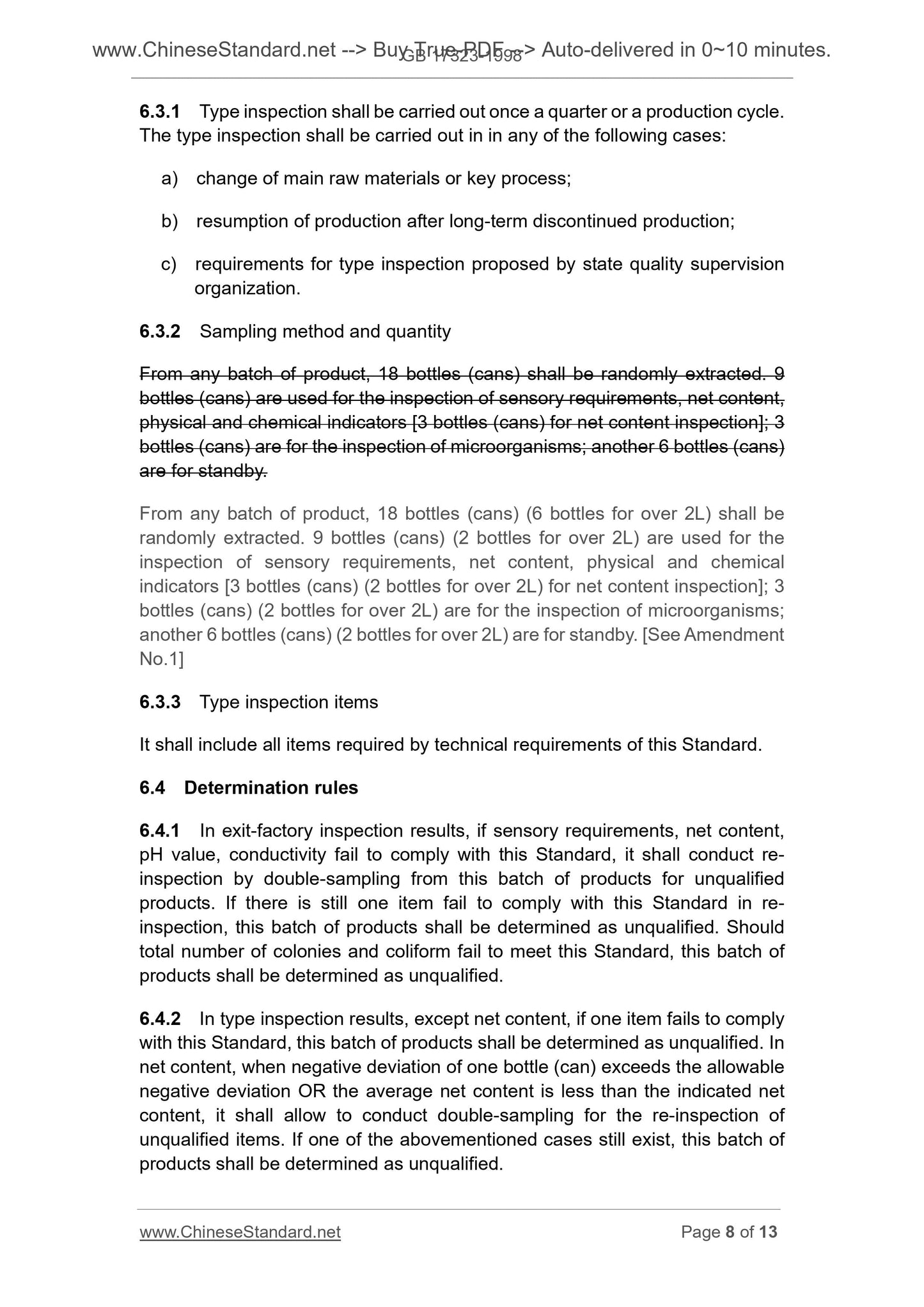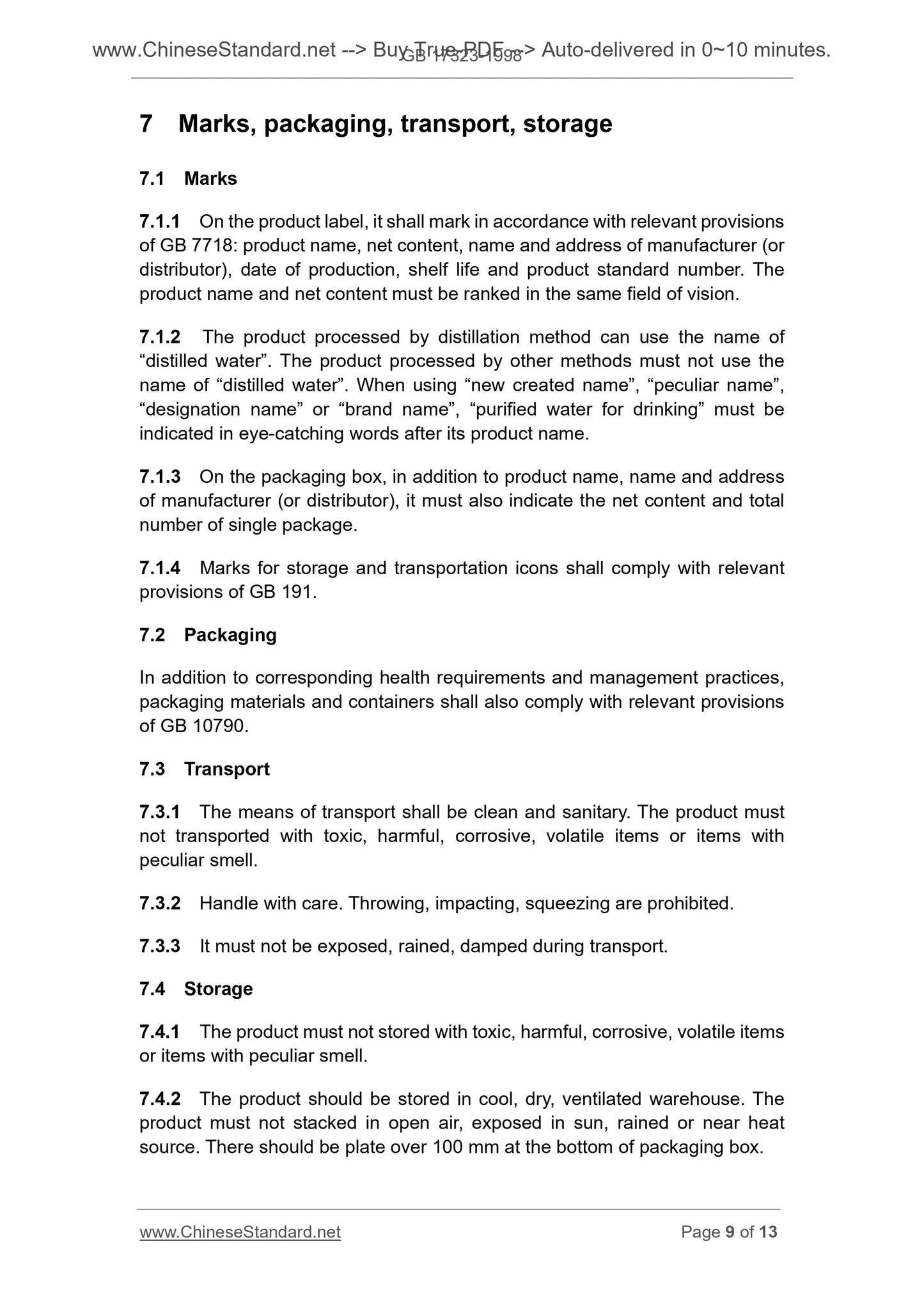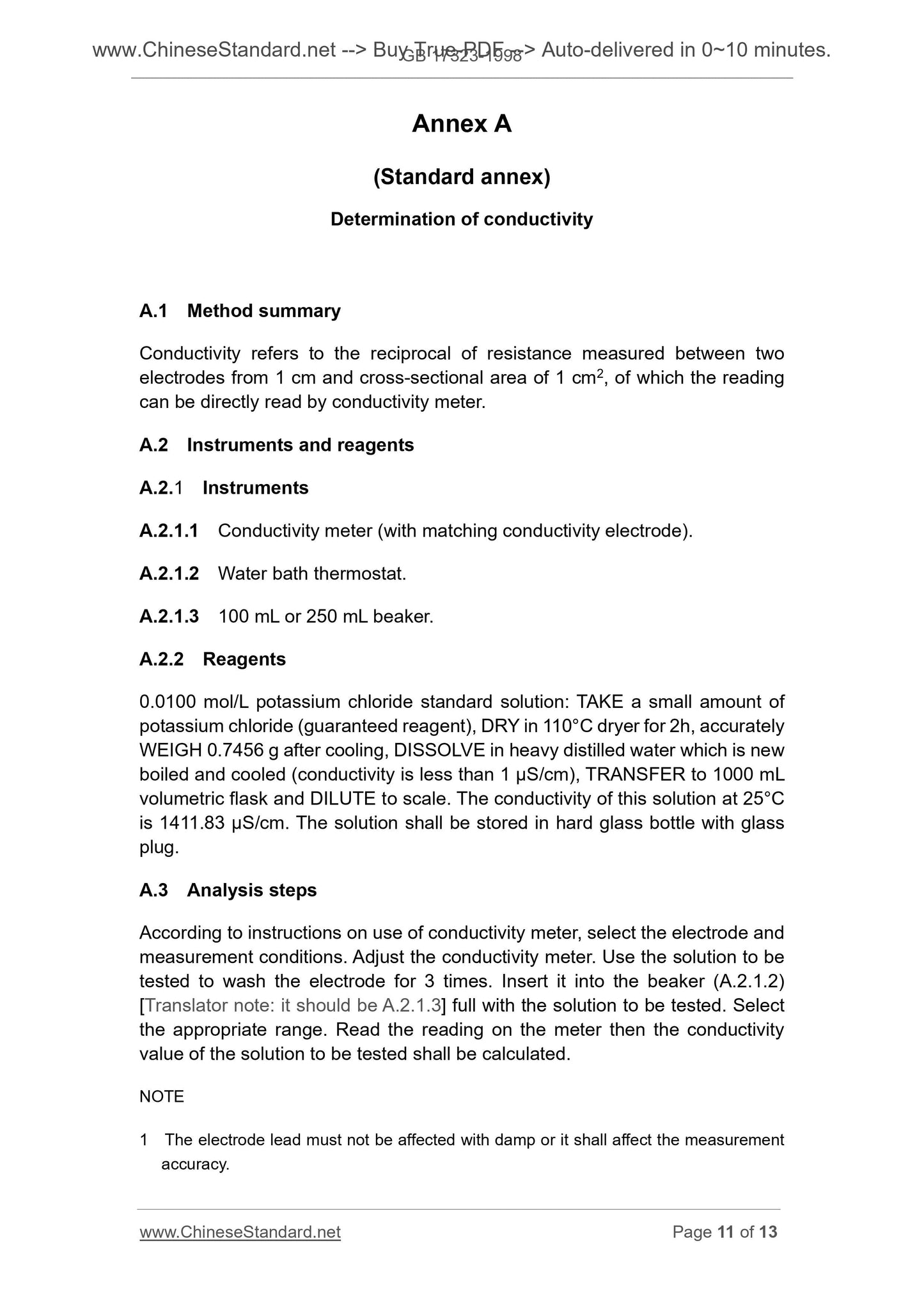1
/
su
7
PayPal, credit cards. Download editable-PDF & invoice in 1 second!
GB 17323-1998 English PDF (GB17323-1998)
GB 17323-1998 English PDF (GB17323-1998)
Prezzo di listino
$70.00 USD
Prezzo di listino
Prezzo scontato
$70.00 USD
Prezzo unitario
/
per
Spese di spedizione calcolate al check-out.
Impossibile caricare la disponibilità di ritiro
Delivery: 3 seconds. Download true-PDF + Invoice.
Get QUOTATION in 1-minute: Click GB 17323-1998
Historical versions: GB 17323-1998
Preview True-PDF (Reload/Scroll if blank)
GB 17323-1998: Bottled purified water for drinking
GB 17323-1998
GB
NATIONAL STANDARD OF
THE PEOPLE’S REPUBLIC OF CHINA
ICS 13.060.20
X 51
Bottled purified water for drinking
ISSUED ON. APRIL 21, 1998
IMPLEMENTED ON. JANUARY 1, 1999
Issued by. China State Bureau of Quality and Technical Supervision
Table of Contents
Foreword ... 3
1 Scope ... 4
2 Normative references ... 4
3 Definition ... 4
4 Technical requirements ... 5
5 Test methods ... 6
6 Inspection rules ... 7
7 Marks, packaging, transport, storage ... 9
Annex A ... 11
Amendment No. 1 of GB 17323-1998 Bottled purified water for drinking ... 13
Foreword
This Standard is a product standard for bottled purified water for drinking. Its
definition, scope all refer to Bottled Water, a modified standard which was
issued by United States Food and Drug Administration (FDA) in 1993.
The test method of “conductivity” is listed in Annex A of this Standard.
This Standard was proposed by China Light Industry Association.
This Standard shall be under the jurisdiction of China National Food
Fermentation Standardization Center.
The drafting organizations of this Standard. China Institute of Food and
Fermentation Industries, Guangzhou Station of China Light Industry
Association of Quality Supervision and Inspection, Shenzhen Yi Bao Food and
Beverage Co., Ltd., Zhaoqing Dinghu Steamed Solid Water Limited, Shenzhen
King Tin Food and Beverage Co., Ltd., Guangdong Jianlibao Beverage Factory.
Main drafters of this Standard. Xu Qingqu, Zhou Damin, Wang Zhihui, Wu
Musheng, Zhou Jingliang, Deng Ruiwen.
This Standard shall be interpreted by China National Food Fermentation
Standardization Center.
Bottled purified water for drinking
1 Scope
This Standard specifies technical requirements, test methods, inspection rules
and marks, packaging, transport, storage requirements for bottled purified
water for drinking. It is applicable to the product defined in Clause 3 of this
Standard.
2 Normative references
The following standards contain the provisions which, through reference in this
Standard, constitute the provisions of this Standard. At the time of publication
of this Standard, the versions shown are valid. All standards shall be revised.
The parties who enter into agreement based on this Standard are encouraged
to investigate whether the latest versions of these documents are applicable.
GB 191-90 Packaging - Pictorial markings for handling of goods
GB 5749-85 Sanitary standard for drinking water
GB 5750-85 Standard examination methods for drinking water
GB 6682-92 Water for analytical laboratory use - Specification and test
methods
GB 7718-94 General standard for the labelling of foods
GB/T 8538-1995 Methods for examination of drinking natural mineral water
GB 10789-1996 Classification of soft drinks
GB 10790-89 Regulations for acceptance, labeling, packaging,
transportation and storage of soft drinks
GB 17324-1998 Hygienic standard of bottled purified water for drinking
3 Definition
This Standard applies the following definition.
3.1 bottled purified water for drinking
6.3.1 Type inspection shall be carried out once a quarter or a production cycle.
The type inspection shall be carried out in in any of the following cases.
a) change of main raw materials or key process;
b) resumption of production after long-term discontinued production;
c) requirements for type inspection proposed by state quality supervision
organization.
6.3.2 Sampling method and quantity
From any batch of product, 18 bottles (cans) shall be randomly extracted. 9
bottles (cans) are used for the inspection of sensory requirements, net content,
physical and chemical indicators [3 bottles (cans) for net content inspection]; 3
bottles (cans) are for the inspection of microorganisms; another 6 bottles (cans)
are for standby.
From any batch of product, 18 bottles (cans) (6 bottles for over 2L) shall be
randomly extracted. 9 bottles (cans) (2 bottles for over 2L) are used for the
inspection of sensory requirements, net content, physical and chemical
indicators [3 bottles (cans) (2 bottles for over 2L) for net content inspection]; 3
bottles (cans) (2 bottles for over 2L) are for the inspection of microorganisms;
another 6 bottles (cans) (2 bottles for over 2L) are for standby. [See Amendment
No.1]
6.3.3 Type inspection items
It shall include all items required by technical requirements of this Standard.
6.4 Determination rules
6.4.1 In exit-factory inspection results, if sensory requirements, net content,
pH value, conductivity fail to comply with this Standard, it shall conduct re-
inspection by double-sampling from this batch of products for unqualified
products. If there is still one item fail to comply with this Standard in re-
inspection, this batch of products shall be determined as unqualified. Should
total number of colonies and coliform fail to meet this Standard, this batch of
products shall be determined as unqualified.
6.4.2 In type inspection results, except net content, if one item fails to comply
with this Standard, this batch of products shall be determined as unqualified. In
net content, when negative deviation of one bottle (can) exceeds the allowable
negative deviation OR the average net content is less than the indicated net
content, it shall allow to conduct double-sampling for the re-inspection of
unqualified items. If one of the abovementioned cases still exist, this batch of
products shall be determined as unqualified.
7 Marks, packaging, transport, storage
7.1 Marks
7.1.1 On the product label, it shall mark in accordance with relevant provisions
of GB 7718. product name, net content, name and address of manufacturer (or
distributor), date of production, shelf life and product standard number. The
product name and net content must be ranked in the same field of vision.
7.1.2 The product processed by distillation method can use the name of
“distilled water”. The product processed by other methods must not use the
name of “distilled water”. When using “new created name”, “peculiar name”,
“designation name” or “brand name”, “purified water for drinking” must be
indicated in eye-catching words after its product name.
7.1.3 On the packaging box, in addition to product name, name and address
of manufacturer (or distributor), it must also indicate the net content and total
number of single package.
7.1.4 Marks for storage and transportation icons shall comply with relevant
provisions of GB 191.
7.2 Packaging
In addition to corresponding health requirements and management practices,
packaging materials and containers shall also comply with relevant provisions
of GB 10790.
7.3 Transport
7.3.1 The means of transport shall be clean and sanitary. The product must
not transported with toxic, harmful, corrosive, volatile items or items with
peculiar smell.
7.3.2 Handle with care. Throwing, impacting, squeezing are prohibited.
7.3.3 It must not be exposed, rained, damped during transport.
7.4 Storage
7.4.1 The product must not stored with toxic, harmful, corrosive, volatile items
or items with peculiar smell.
7.4.2 The product should be stored in cool, dry, ventilated warehouse. The
product must not stacked in open air, exposed in sun, rained or near heat
source. There should be plate over 100 mm at the bottom of packaging box.
Annex A
(Standard annex)
Determination of conductivity
A.1 Method summary
Conductivity refers to ...
Get QUOTATION in 1-minute: Click GB 17323-1998
Historical versions: GB 17323-1998
Preview True-PDF (Reload/Scroll if blank)
GB 17323-1998: Bottled purified water for drinking
GB 17323-1998
GB
NATIONAL STANDARD OF
THE PEOPLE’S REPUBLIC OF CHINA
ICS 13.060.20
X 51
Bottled purified water for drinking
ISSUED ON. APRIL 21, 1998
IMPLEMENTED ON. JANUARY 1, 1999
Issued by. China State Bureau of Quality and Technical Supervision
Table of Contents
Foreword ... 3
1 Scope ... 4
2 Normative references ... 4
3 Definition ... 4
4 Technical requirements ... 5
5 Test methods ... 6
6 Inspection rules ... 7
7 Marks, packaging, transport, storage ... 9
Annex A ... 11
Amendment No. 1 of GB 17323-1998 Bottled purified water for drinking ... 13
Foreword
This Standard is a product standard for bottled purified water for drinking. Its
definition, scope all refer to Bottled Water, a modified standard which was
issued by United States Food and Drug Administration (FDA) in 1993.
The test method of “conductivity” is listed in Annex A of this Standard.
This Standard was proposed by China Light Industry Association.
This Standard shall be under the jurisdiction of China National Food
Fermentation Standardization Center.
The drafting organizations of this Standard. China Institute of Food and
Fermentation Industries, Guangzhou Station of China Light Industry
Association of Quality Supervision and Inspection, Shenzhen Yi Bao Food and
Beverage Co., Ltd., Zhaoqing Dinghu Steamed Solid Water Limited, Shenzhen
King Tin Food and Beverage Co., Ltd., Guangdong Jianlibao Beverage Factory.
Main drafters of this Standard. Xu Qingqu, Zhou Damin, Wang Zhihui, Wu
Musheng, Zhou Jingliang, Deng Ruiwen.
This Standard shall be interpreted by China National Food Fermentation
Standardization Center.
Bottled purified water for drinking
1 Scope
This Standard specifies technical requirements, test methods, inspection rules
and marks, packaging, transport, storage requirements for bottled purified
water for drinking. It is applicable to the product defined in Clause 3 of this
Standard.
2 Normative references
The following standards contain the provisions which, through reference in this
Standard, constitute the provisions of this Standard. At the time of publication
of this Standard, the versions shown are valid. All standards shall be revised.
The parties who enter into agreement based on this Standard are encouraged
to investigate whether the latest versions of these documents are applicable.
GB 191-90 Packaging - Pictorial markings for handling of goods
GB 5749-85 Sanitary standard for drinking water
GB 5750-85 Standard examination methods for drinking water
GB 6682-92 Water for analytical laboratory use - Specification and test
methods
GB 7718-94 General standard for the labelling of foods
GB/T 8538-1995 Methods for examination of drinking natural mineral water
GB 10789-1996 Classification of soft drinks
GB 10790-89 Regulations for acceptance, labeling, packaging,
transportation and storage of soft drinks
GB 17324-1998 Hygienic standard of bottled purified water for drinking
3 Definition
This Standard applies the following definition.
3.1 bottled purified water for drinking
6.3.1 Type inspection shall be carried out once a quarter or a production cycle.
The type inspection shall be carried out in in any of the following cases.
a) change of main raw materials or key process;
b) resumption of production after long-term discontinued production;
c) requirements for type inspection proposed by state quality supervision
organization.
6.3.2 Sampling method and quantity
From any batch of product, 18 bottles (cans) shall be randomly extracted. 9
bottles (cans) are used for the inspection of sensory requirements, net content,
physical and chemical indicators [3 bottles (cans) for net content inspection]; 3
bottles (cans) are for the inspection of microorganisms; another 6 bottles (cans)
are for standby.
From any batch of product, 18 bottles (cans) (6 bottles for over 2L) shall be
randomly extracted. 9 bottles (cans) (2 bottles for over 2L) are used for the
inspection of sensory requirements, net content, physical and chemical
indicators [3 bottles (cans) (2 bottles for over 2L) for net content inspection]; 3
bottles (cans) (2 bottles for over 2L) are for the inspection of microorganisms;
another 6 bottles (cans) (2 bottles for over 2L) are for standby. [See Amendment
No.1]
6.3.3 Type inspection items
It shall include all items required by technical requirements of this Standard.
6.4 Determination rules
6.4.1 In exit-factory inspection results, if sensory requirements, net content,
pH value, conductivity fail to comply with this Standard, it shall conduct re-
inspection by double-sampling from this batch of products for unqualified
products. If there is still one item fail to comply with this Standard in re-
inspection, this batch of products shall be determined as unqualified. Should
total number of colonies and coliform fail to meet this Standard, this batch of
products shall be determined as unqualified.
6.4.2 In type inspection results, except net content, if one item fails to comply
with this Standard, this batch of products shall be determined as unqualified. In
net content, when negative deviation of one bottle (can) exceeds the allowable
negative deviation OR the average net content is less than the indicated net
content, it shall allow to conduct double-sampling for the re-inspection of
unqualified items. If one of the abovementioned cases still exist, this batch of
products shall be determined as unqualified.
7 Marks, packaging, transport, storage
7.1 Marks
7.1.1 On the product label, it shall mark in accordance with relevant provisions
of GB 7718. product name, net content, name and address of manufacturer (or
distributor), date of production, shelf life and product standard number. The
product name and net content must be ranked in the same field of vision.
7.1.2 The product processed by distillation method can use the name of
“distilled water”. The product processed by other methods must not use the
name of “distilled water”. When using “new created name”, “peculiar name”,
“designation name” or “brand name”, “purified water for drinking” must be
indicated in eye-catching words after its product name.
7.1.3 On the packaging box, in addition to product name, name and address
of manufacturer (or distributor), it must also indicate the net content and total
number of single package.
7.1.4 Marks for storage and transportation icons shall comply with relevant
provisions of GB 191.
7.2 Packaging
In addition to corresponding health requirements and management practices,
packaging materials and containers shall also comply with relevant provisions
of GB 10790.
7.3 Transport
7.3.1 The means of transport shall be clean and sanitary. The product must
not transported with toxic, harmful, corrosive, volatile items or items with
peculiar smell.
7.3.2 Handle with care. Throwing, impacting, squeezing are prohibited.
7.3.3 It must not be exposed, rained, damped during transport.
7.4 Storage
7.4.1 The product must not stored with toxic, harmful, corrosive, volatile items
or items with peculiar smell.
7.4.2 The product should be stored in cool, dry, ventilated warehouse. The
product must not stacked in open air, exposed in sun, rained or near heat
source. There should be plate over 100 mm at the bottom of packaging box.
Annex A
(Standard annex)
Determination of conductivity
A.1 Method summary
Conductivity refers to ...
Share
